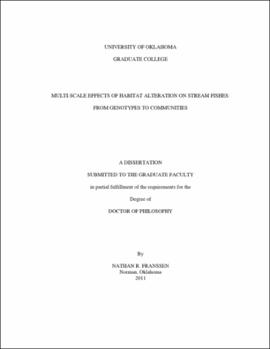| dc.contributor.advisor | Marsh-Matthews, Edith | |
| dc.creator | Franssen, Nathan Ryan | |
| dc.date.accessioned | 2019-05-01T17:22:58Z | |
| dc.date.available | 2019-05-01T17:22:58Z | |
| dc.date.issued | 2011 | |
| dc.identifier | 99112478402042 | |
| dc.identifier.uri | https://hdl.handle.net/11244/319409 | |
| dc.description.abstract | Understanding how evolutionary and ecological processes interact with altered habitats at these various scales will be a major challenge to conservation biologists in the coming decades, and will be crucial for predicting and alleviating deleterious effects of habitat modification. | |
| dc.description.abstract | Although the immediate effects of habitat alteration on organisms are often easily recognized, consequences that may emerge over larger spatial and temporal scales may not be as evident. At the landscape scale, populations can exhibit metapopulation structures, where, in order to remain viable, sink populations are reliant on migrants from source populations. Habitat alteration may reduce the suitability of migration corridors among source and sink populations, disrupting natural metapopulation dynamics. However, the resultant effects on populations may only be evident after a significant lag-time, when the deleterious effects of population isolation are manifested. | |
| dc.description.abstract | The same habitat alterations that can reduce migration rates also have the potential to interact with populations over longer time scales. Native species persisting in locally altered habitats are subjected to novel selective pressures; yet, the evolutionary impacts of these novel selections on resident populations are often overlooked. Local selective pressures may drive local adaptation in modified environments, altering the evolutionary trajectories of populations and potentially making individuals maladapted to more natural habitats. | |
| dc.description.abstract | Regardless of the spatial and temporal scale used to examine the effects of human-induced habitat modification on organisms, the end point is often the extinction or local extirpation of species. Loss of species from communities may influence other biotic and abiotic components of ecosystems such as community dynamics, nutrient fluxes, and ecosystem function. Thus, habitat alteration not only has the potential to affect population-level dynamics over space and time, but also to alter larger components of ecological systems through extirpation of species. | |
| dc.description.abstract | In the first chapter, I assessed the potential for habitat alteration, specifically reservoirs, to alter gene flow among reservoir fragmented stream fish populations. Using microsatellite markers, I assessed the spatial genetic structure of populations of a common minnow (Cyprinidae), red shiner (Cyprinella lutrensis), in and around Lake Texoma, (OK/TX), USA, and tested for lower genetic diversity in two direct tributary populations that have historically experienced population declines and recently have increased in abundance. I found populations were genetically isolated by distance with little differentiation among most populations. However, in one direct tributary population, there was substantial genetic differentiation, and genetic diversity was significantly lower compared to other populations. Gene flow appeared to be lower in reservoir habitats compared to intact stream segments, suggesting reservoirs may be reducing migration among historically connected populations. | |
| dc.description.abstract | In the second chapter, I explored how habitat alteration may result in novel selective pressures that could drive morphological divergence in resident populations. I quantified body shape variation of C. lutrensis in streams and reservoirs from seven reservoir basins in Oklahoma, USA. Body shape significantly and consistently diverged in reservoirs compared to stream habitats within reservoir basins; individuals from reservoir populations were deeper-bodied and had shorter heads compared to stream populations. Stream populations were also increasingly different from reservoir populations as distance from reservoirs increased. I also assessed the relative contribution of population-level and predator-induced phenotypic plasticity on observed body shape variation by rearing offspring from a reservoir and a stream population with or without a piscivorous fish. Significant population-level differences in body shape persisted in offspring, and both populations demonstrated similar predator-induced phenotypic plasticity. My results suggest that, although components of body shape are plastic, anthropogenic habitat modification can drive trait divergence in native fish populations. | |
| dc.description.abstract | In the third chapter, we (myself, Dr. Michael Tobler, and Dr. Keith B. Gido) investigated the potential effects of biodiversity losses on community-level dynamics. Using a long-term dataset of 35 stream fish communities matched with hydrologic data, we showed that community stability (annual variation of standing biomass of fishes) was less variable in more species-rich communities and was not associated with stream hydrology. Our findings suggest anthropogenically induced extirpation of vertebrate consumers may lower community biomass stability in complex ecosystems. | |
| dc.format.extent | 139 pages | |
| dc.format.medium | application.pdf | |
| dc.language | en_US | |
| dc.relation.requires | Adobe Acrobat Reader | |
| dc.subject | Reservoirs--Environmental aspects | |
| dc.subject | Fishes--Habitat | |
| dc.subject | Fish populations | |
| dc.subject | Biodiversity | |
| dc.subject | Cyprinidae | |
| dc.title | Multi-scale effects of habitat alteration on stream fishes: from genotypes to communities | |
| dc.type | text | |
| dc.type | document | |
| dc.thesis.degree | Ph.D. | |
| ou.group | College of Arts and Sciences::Department of Biology | |
